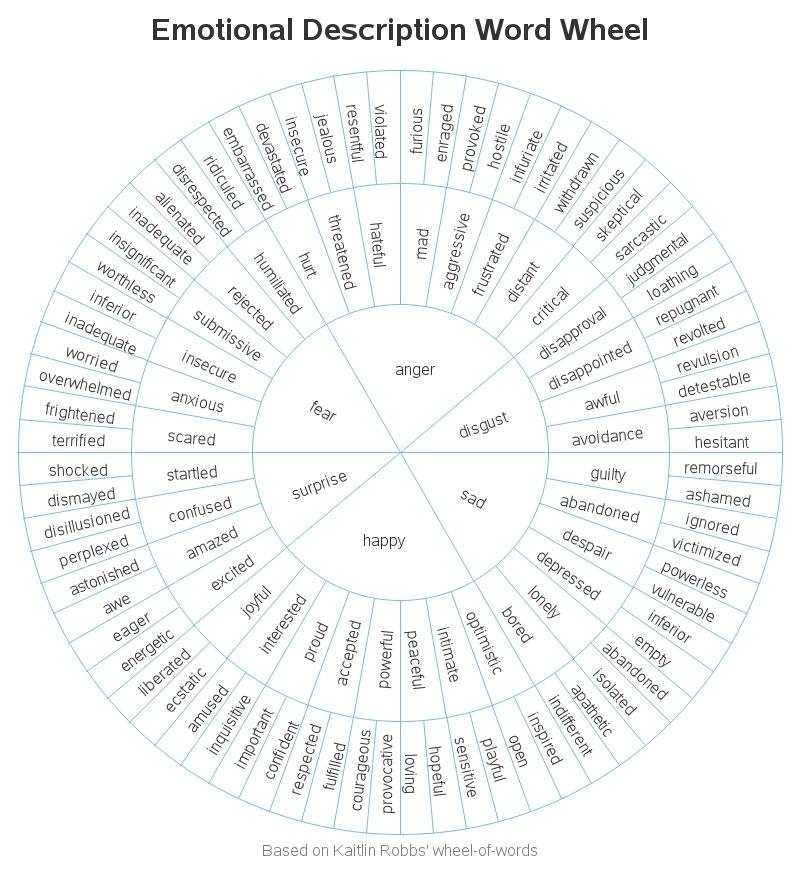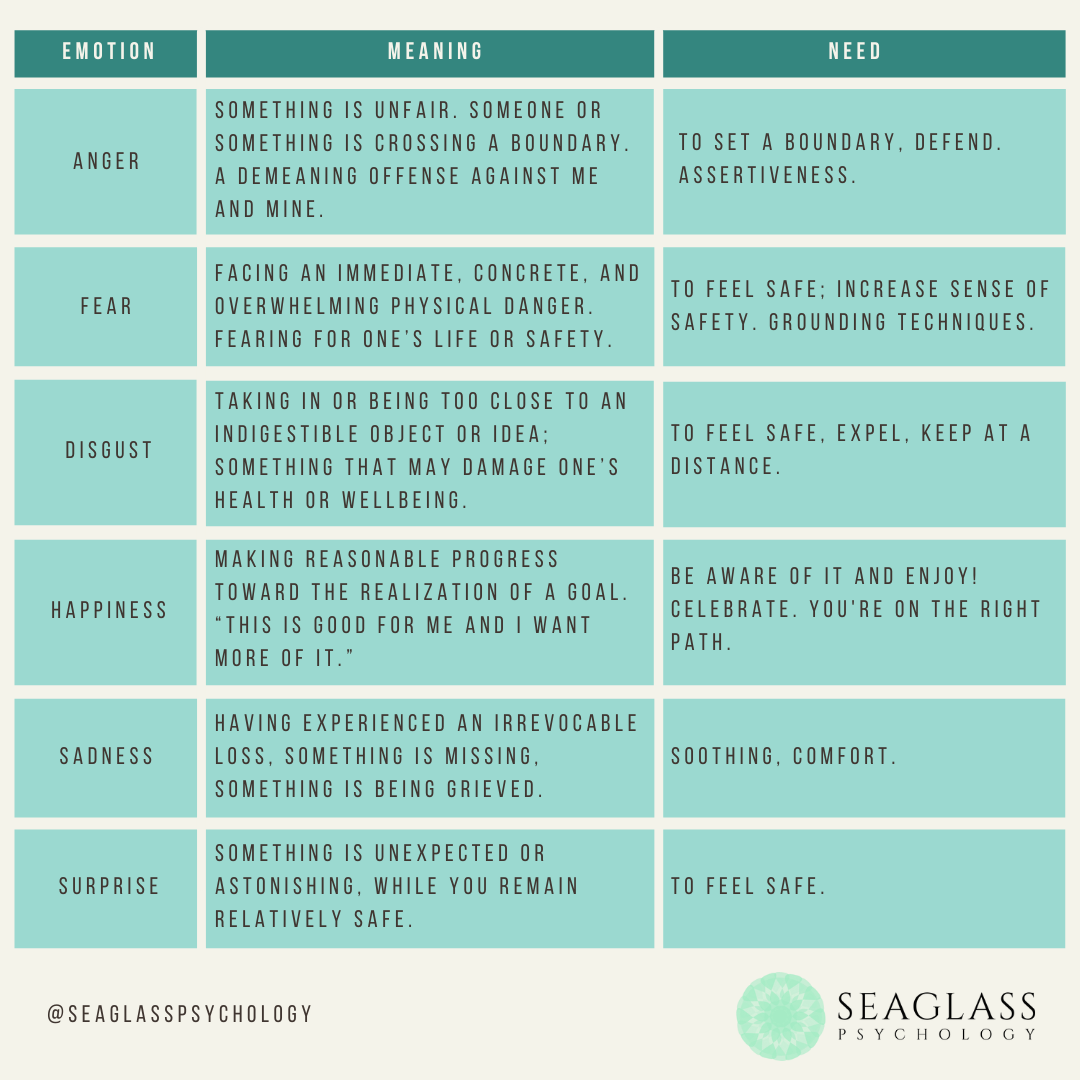
Basic Emotions: Their meaning and need
May 26, 2021 | Emotions, General
If you remember, we started off the month with Canadian Mental Health Week (in the US it’s Mental Health Awareness Month, too). The theme this year was “understanding our emotions” and, since that’s one of my favourite topics, I decided to talk about it all through May. In my last post, I told you what emotions are, according to psychology, and how they provide a wealth of information. I believe we all intuitively know that the more information we have, the better choices we can make, right? But what kind of information can emotions give us? That’s what I want to answer in this post by telling you about basic emotions, their meaning and their needs.
So, to recap, we said that an emotion is divided into different parts that happen quickly and automatically. We also learned that, if we pay attention to what happens during an emotion, we can eventually change the way we assess an event and how we respond to it. By engaging our awareness, then, we’re using a fully connected brain to process our inner experience. That way, we can integrate the full range of our meaning-making machine and use that to our benefit. At the same time, if we know what we’re feeling and how to interpret that information, we can gain access to our beliefs and needs.
Also, when we hear and address our emotions, they tend to reduce in intensity or even disappear (which is different than repressing them). Research suggests that just the process of labelling emotions can reduce distress.
To facilitate this process, it can be helpful to talk about basic emotions.
What are the basic emotions?
The idea of core emotions isn’t settled in research. Multiple models exist (you can find two different overviews of theories of emotion here: 1, 2). In my practice, I integrate Paul Ekman’s reasearch as well as neurological research to help label and organize emotions. Based on these two sets of evidence, I work with six basic emotions: joy, sadness, anger, disgust, fear, and surprise. Out of these six, anger and disgust start in similar parts of the brain, separating into one of the two depending on how the brain cycles through the assessment of an event. The same is the case for fear and surprise.
Using the idea of basic emotions simplifies the exploration of an emotion. To provide an example, let’s take a look at this emotions wheel:

If we’re unsure of what we feel, we might go through the outer ring and define we feel awe. Travelling inwards to the inner circle, we can see that it’s a feeling that relates to surprise. Conversely, to gain specificity and broaden our emotional vocabulary, we may follow the opposite path, and go from the inner circle out. A wheel like this isn’t perfect; I encourage you to base your choice on what makes sense to you, and choosing the labels that best fit what you’re feeling.
Now that we have a basic emotion, we can start connecting it to their general meaning and needs.
The meaning and need of an emotion
Did you know that emotions can be categorized by the themes they relate to? Look at the table below:

Description: A table organizing emotions, their meaning, and the need within.
| Emotion | Meaning | Need |
| Anger | Something is unfair. Someone or something is crossing a boundary. A demeaning offense against me and mine. | To set a boundary, defend. Assertiveness. |
| Fear | Facing an immediate, concrete, and overwhelming physical danger. Fearing for one’s life or safety. | To feel safe; increase sense of safety. Grounding techniques. |
| Disgust | Taking in or being too close to an indigestible object or idea; something that may damage one’s health or wellbeing. | To feel safe, expel, keep at a distance. |
| Happiness | Making reasonable progress toward the realization of a goal. “This is good for me and I want more of it.” | Be aware of it and enjoy! Celebrate. You’re on the right path. |
| Sadness | Having experienced an irrevocable loss, something is missing, something is being grieved. | Soothing, comfort. |
| Surprise | Something is unexpected or astonishing, while you remain relatively safe. | To feel safe. |
You can download a printable PDF of the graphic version of this table to carry around on paper or your phone for easy reference.
Organizing the information
After finding the core emotion and reviewing the theme held in that particular feeling, you may explore your experience with new depth. If you’re angry, what was the offense? What are the boundaries you need to set? If you’re scared, what’s the threat? Are you anxious about it? How do you find safety?
The process of unpacking how we feel can in itself create important change within ourselves. Additionally, it’s one of the aspects of living with plenitude. Of course, it can feel new: how many of us were taught what to do about how we feel? That’s to be expected. Rest assured, the more we practice, the higher the confidence we’ll feel in managing our experience. I have been using this skill in my life for years and I’ve taught it to many people. I can’t wait until you experiment with it and decide whether it can bring the same kind of positive impact to your life as it’s had for me and for many of my clients.
I grew up speaking Spanish. English is my second language. When I communicate in English, I make mistakes. I've chosen to let the writing on my blog reflect the kind of mistakes I make when speaking, so that you have an idea of what it might feel like to talk to me. I trust the message is still clear but, if it's not, please don't hesitate to ask me for clarification.
The information provided on my blog is a mix of my personal thoughts, professional approach, and articles related to mental health. The purpose of sharing all of this is to communicate the models at the core of my practice, as well as to provide education. I hope this will help to minimize some of the power imbalances related to my profession. The articles on this blog should not be considered as professional advice for any one person or group of people. If you have any questions about the appropriateness of this content for you, please contact a qualified mental health professional.